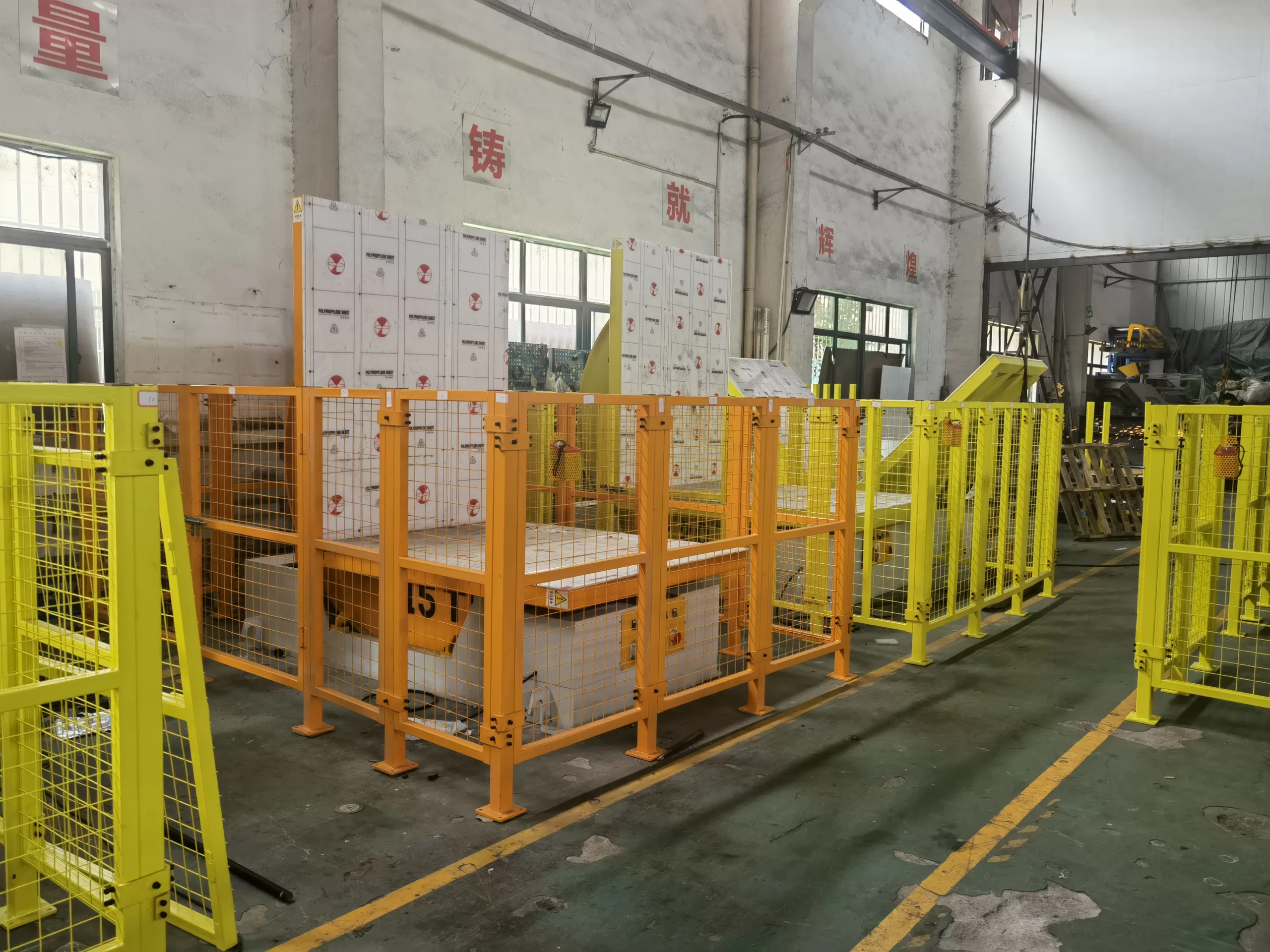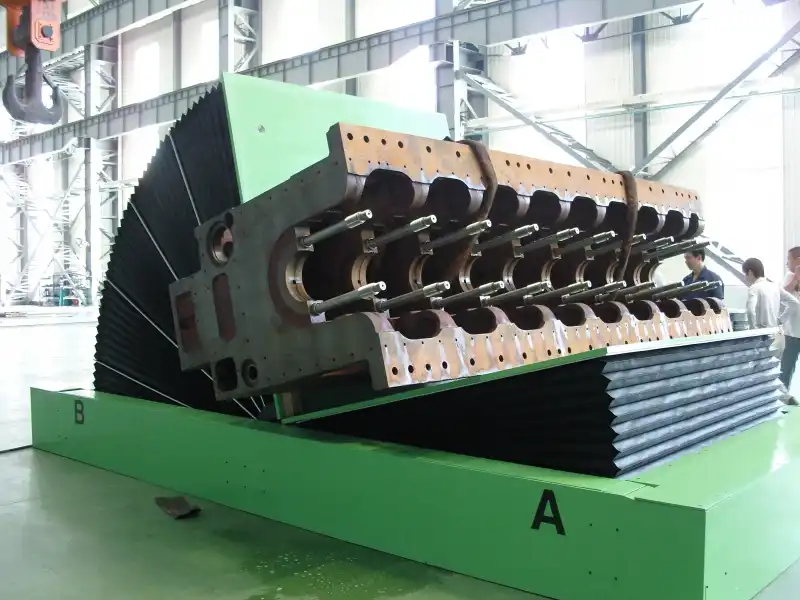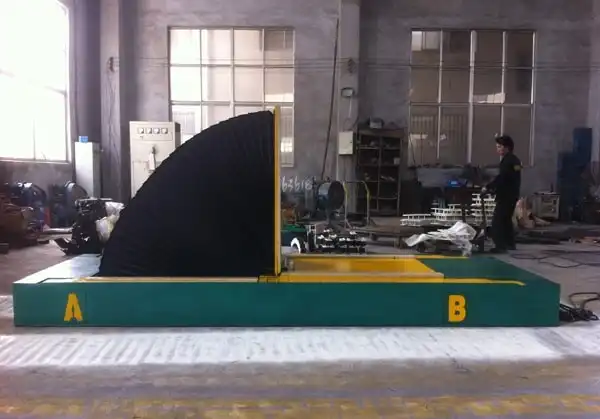Looking to Automate Mold Handling? Here’s the Smartest Choice for U.S. Industry
Are you running a steel mill in the U.S. and feeling the pressure? I see it all the time. Your manual or semi-automated mold handling process is a major bottleneck. It's slow, it's dangerous, and every minute of downtime costs you a fortune. You worry about the safety of your crew working around massive, hot equipment. You also see the numbers on your balance sheet, and you know the high labor costs and risks of equipment damage are eating into your profits. You need a better way, a solution that not only solves these problems but also sets you up for future growth.
The smartest choice for automating mold handling in the U.S. industry is a fully integrated, custom-engineered system from a strategic partner. This solution combines heavy-duty, reliable mechanics with modern IoT connectivity and data analysis. It is designed not just as a machine, but as a complete solution to improve safety, efficiency, and your bottom line.

I know that sounds like a big claim. You’ve probably heard promises from dozens of equipment suppliers. But I'm not just a supplier. My name is Vincent Liu, and I’ve spent my entire career in this industry, first as an engineer on the factory floor and later as the founder of my own packing machine factory, SHJLPACK. I’ve worked with leaders like Javier Morales, a steel mill owner who faces the exact same challenges you do: aging equipment, rising energy costs, and the constant pressure to improve efficiency. He understands that a piece of equipment is not just a purchase; it's a strategic investment. Let’s break down why this approach is the only one that makes sense for a forward-thinking U.S. steel operation.
How can automated mold handling slash operational costs and boost ROI?
You look at your operational budget every month and see the same things. High labor costs for tough, physical jobs. Unexpected maintenance bills when old equipment fails. Production delays that ripple through your entire schedule. You’re under immense pressure to justify every capital expense, and you need to be sure any new investment will pay for itself, and quickly. The thought of spending a significant amount on a new system is daunting if the return isn't crystal clear. But the real question is, can you afford to continue with the current system, which is slowly bleeding money and efficiency every single day?
Automated mold handling provides a powerful and direct return on investment (ROI) by systematically cutting your biggest operational costs. It reduces the need for manual labor in hazardous roles, minimizes expensive damage to molds and equipment from human error, and dramatically speeds up changeover times. This leads to higher throughput, less downtime, and a tangible ROI that often materializes in under 24 months.
%[An automated line for Rugged Industrial Mold Upender](https://www.fhopepack.com/blog/wp-content/uploads/2024/05/upender-machine.webp"Rugged Industrial Mold Upender")
Let's dive deeper into how this actually works on your factory floor and on your financial statements. It's not magic; it's just smart engineering applied to your biggest pain points. We need to look beyond the initial price tag and analyze the Total Cost of Ownership (TCO) and the total value it brings.
Deconstructing the ROI
When I work with clients, I help them build a business case. We don't just talk about features; we talk about dollars and cents. An automated mold handling system impacts your bottom line in several key areas.
| Cost Center | Impact of Manual/Old System | Impact of Automated System | Financial Benefit |
|---|---|---|---|
| Labor Costs | High cost for 2-3 operators per shift in a high-risk zone. High turnover and training costs. | Reduces direct labor to one supervisor. Re-deploys skilled workers to higher-value tasks. | Immediate reduction in payroll for that specific task. |
| Equipment Damage | Molds are frequently bumped or dropped, causing cracks and requiring costly repairs or replacement. Crane components wear out faster. | Gentle, precise, and repeatable handling with soft start/stop functions. Zero impact on molds. | Drastically reduced mold repair budget. Extended life for molds and lifting equipment. |
| Production Downtime | Mold changes are slow, inconsistent, and can take hours, halting the entire casting line. | Mold changes are fast, predictable, and can be completed in a fraction of the time. | Increased production uptime. For a mill producing thousands of tons a day, this translates to millions in revenue. |
| Safety & Insurance | High risk of serious injury or fatality. This leads to high workers' compensation premiums and potential legal costs. | Virtually eliminates human presence in the danger zone. Systems have built-in fail-safes. | Lower insurance premiums. A safer workplace improves morale and productivity. Avoids catastrophic financial and human costs of an accident. |
When you add these up, the case becomes clear. A client like Javier, aiming to reduce overall operating costs by 8%, can achieve a significant portion of that goal from this one project alone. The savings in labor, maintenance, and insurance, combined with the massive revenue gain from increased uptime, create an ROI that is not just theoretical but practical and measurable.
What are the key features of a reliable mold handling system for a modern steel mill?
You've been burned before. A supplier promised you the moon, delivered a machine that didn't work as advertised, and then was nowhere to be found when you needed support. Your maintenance team is already stretched thin dealing with your 15-year-old equipment. The last thing you need is another "black box" that no one understands or can fix. You have a right to be skeptical. You need to know exactly what to look for, what separates a truly robust, reliable system from a cheap one that will fail under the harsh conditions of your mill.
The key features of a reliable mold handling system for a modern U.S. steel mill are a combination of brute strength and intelligence. It must have a heavy-duty mechanical structure built for the environment, precision controls for gentle movement, multi-layered safety systems, and seamless data integration with your plant's control systems. It should also be modular for easy maintenance and future expansion.

Let's get specific. As an engineer, these are the non-negotiable elements I build into my designs and what you should demand from any potential partner. Anything less is a compromise you can't afford to make.
Core System Attributes
A system is only as strong as its weakest link. For a steel mill, this means every component has to be over-engineered for durability.
-
### Heavy-Duty Mechanical Construction
This is the foundation. The frame must be built from thick, high-strength structural steel, with certified welds. It needs to withstand not just the weight of the mold but also the heat, dust, and constant vibration of a steel mill. All moving parts, like wheels, bearings, and gearboxes, should be from top-tier, internationally recognized brands. This isn't the place to save money with no-name components. I insist on using oversized components that are rated for far more than the required load. This builds in a huge factor of safety and ensures a long service life with minimal wear. -
### Precision Control and Gentle Handling
Strength is useless without control. A reliable system uses Variable Frequency Drives (VFDs) on all motors. This allows for smooth, programmable acceleration and deceleration. The result? No jerking, no swinging, and no hard stops. The system gently lifts, moves, and places the mold with sub-millimeter accuracy. This is all managed by a robust PLC (Programmable Logic Controller), like a Siemens or Allen-Bradley, which is the brain of the operation. This precision is what protects your expensive molds from damage and ensures a perfect handoff every time. -
### Multi-Layered Safety Integration
Safety cannot be an afterthought. A modern system goes far beyond an emergency stop button.- Zone Scanners: Laser scanners create invisible safety zones around the machine. If a person or forklift enters the operating area, the machine automatically slows down or stops.
- Anti-Collision Sensors: Sensors on the machine prevent it from colliding with other equipment or building structures.
- Mechanical Fail-Safes: In case of a power failure, fail-safe brakes on all motors engage instantly, preventing a load from dropping.
- Interlocks: The system is interlocked with the overhead crane and other equipment. It cannot perform a dangerous action, like moving while a mold is being lifted.
Here's a simple breakdown of what to look for:
| Feature | Basic System (The Wrong Choice) | Reliable System (The Smart Choice) |
|---|---|---|
| Control | On/Off contactors. Jerky starts and stops. | VFDs on all motors. Smooth, controlled movement. |
| Safety | E-stop button only. | Integrated laser scanners, anti-collision, fail-safes. |
| Construction | Lighter gauge steel. Generic components. | Heavy-duty structural steel. Premium, oversized components. |
| Connectivity | Isolated "black box." No data output. | Full integration with MES/SCADA. Provides operational data. |
For a leader like Javier, who wants to build a digital factory, the connectivity piece is crucial. A reliable system isn't just a machine; it's a node in your information network, providing valuable data for your MES and predictive maintenance platforms.
Why is a strategic partner more valuable than just a supplier for this upgrade?
You have a clear need: you need to automate your mold handling. The standard process is to send out a request for quotation to a few companies. You get back three different prices, and the temptation is to choose the cheapest one. It seems like the most fiscally responsible decision. But is it? I've seen this story play out many times. The company with the lowest price delivers a standard, off-the-shelf machine. The installation is a nightmare because it doesn't quite fit your space. Your team isn't trained properly. And six months later, when you need a small change or a spare part, the supplier is unresponsive. You saved money on the purchase order, but now you're losing much more in downtime and frustration.
A strategic partner is more valuable than a simple supplier because they are invested in your success for the long term. They don't just sell you a machine; they provide a total solution that includes in-depth consultation, custom design to your exact needs, seamless integration with your plant, comprehensive training for your team, and ongoing support for the life of the equipment.

This is the core of my philosophy at SHJLPACK. I achieved my own success by helping my clients become more successful. It's a simple concept, but it changes everything about the business relationship. Let’s break down the real-world difference.
Supplier vs. Partner: A Critical Distinction
Thinking about this in terms of a partnership fundamentally changes the process and the outcome. It's the difference between buying a tool and hiring an expert craftsman who brings his own custom tools.
| Aspect | The Supplier Mindset | The Partner Mindset |
|---|---|---|
| Goal | Make a one-time sale. Move on to the next customer. | Build a long-term relationship. Ensure client success. |
| Process | Offer a standard product from a catalog. | Conduct deep analysis of your unique workflow and goals. |
| Solution | "Here is our machine. Make it fit." | "Let's design a system that solves your specific problem." |
| Support | Limited to warranty claims. Slow response. | Proactive support, training, and optimization advice. |
| Focus | Product features and lowest price. | Your ROI, TCO, and long-term operational excellence. |
The Partnership Journey in Practice
-
1. Deep Consultation: A partner starts by listening. I would want to walk your floor, talk to your operators and maintenance crew, and understand your entire process flow from casting to the next stage. I'd ask about your goals, like Javier's mission to increase uptime to 95% and implement digital tools. A supplier just asks for the mold's weight and dimensions.
-
2. Custom Engineering: No two steel mills are identical. A partner designs the system around your existing layout, your specific mold types, and your operational quirks. We use 3D modeling to show you exactly how the system will fit and function before a single piece of steel is cut. This eliminates surprises during installation.
-
3. Seamless Integration: A partner understands that the mold handling system must communicate with your other systems. We handle the PLC programming to ensure it "talks" to your overhead crane, your casting line controls, and your MES platform. It becomes a smart component of your factory, not a dumb, isolated machine.
-
4. Comprehensive Training and Support: The project isn't over when the machine is installed. A partner provides in-depth, on-site training for both your operators and your maintenance staff. We provide detailed documentation, spare parts lists, and a direct line for support. Our success depends on your team being confident and capable of running and maintaining the system.
This approach transforms the investment from a simple capital expenditure into a strategic competitive advantage.
My Insights: It's Not About the Machine, It's About the Flow
Over my years in this business, from my first days on the factory floor to running SHJLPACK, I've learned one crucial lesson. When clients come to me asking for a "wrapping machine" or a "handling system," what they are really asking for is a better, more efficient, and more profitable process. The machine is just the tool to achieve that.
When I started my own factory, I made mistakes. I sometimes bought equipment based on the lowest price, only to pay for it later in downtime and repairs. I learned the hard way that the initial purchase price is only a small part of the story. The real cost—and the real value—is in how that equipment affects your entire operational flow. This is the knowledge I want to share with leaders in the U.S. steel industry.
First, look beyond the price tag to the Total Cost of Ownership (TCO). A cheap machine that requires constant maintenance, consumes more energy, and causes production stoppages is infinitely more expensive than a well-engineered system with a higher initial cost. A leader like Javier, who rigorously analyzes ROI, understands this. The smart choice is the one that provides the most value over its 20-year lifespan, not the one that looks cheapest on paper today.
Second, remember that data is the new steel. In a modern factory, every piece of equipment should be a source of valuable information. An automated system that doesn't connect to your network and provide data on cycle times, component health, and energy usage is a missed opportunity. This data is essential for achieving goals like predictive maintenance and 95% uptime. Insist that your equipment is a smart part of your digital ecosystem.
Finally, automation is not about replacing people; it's about empowering them. The goal of automating a dangerous job like mold handling is to move your skilled workers out of harm's way and into higher-value roles. They can move from manual labor to supervising automated systems, analyzing performance data, and focusing on process improvement. This creates a safer, more engaging, and ultimately more productive work environment for everyone.
Conclusion
Automating mold handling with a strategic partner isn't just an upgrade; it's a foundational step toward a safer, more efficient, and more profitable future for your U.S. steel mill.





